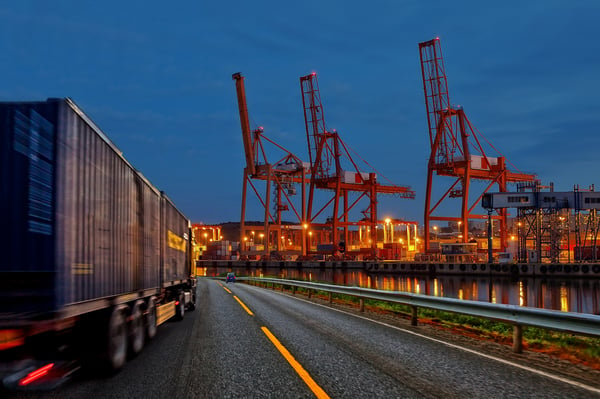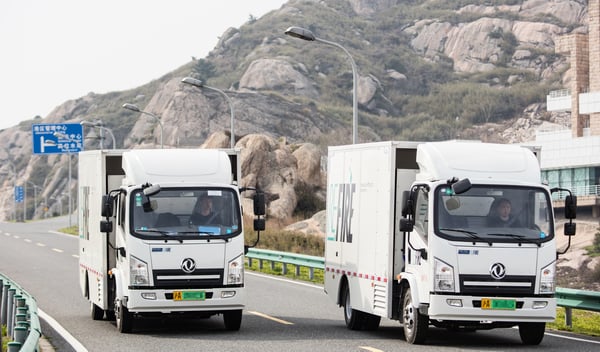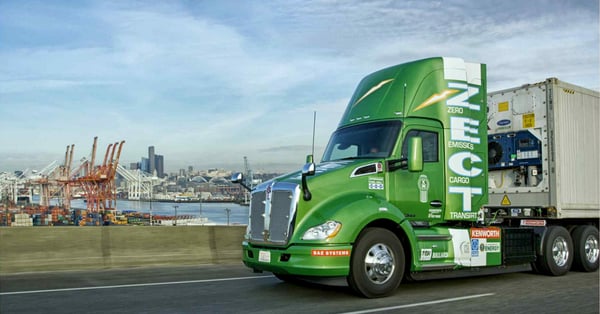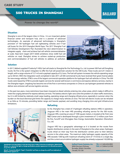It seems like an impossible contradiction: for the sake of the planet, greenhouse gas emissions from vehicles must go down significantly. And yet, with global trade and e-commerce thriving, freight volumes are projected to grow 40% by 2050.
The situation is real.

The increase in freight traffic is about to meet environmental pressures (and government legislation) head on. Truck fleet operators don’t have to look very far into the future to see that drastic change is on the way.
How can they deal with this looming challenge?
 This article proposes some technological advancement that will transform the freight industry, including a robust, proven solution for zero-emission heavy transport powered by hydrogen fuel cells.
This article proposes some technological advancement that will transform the freight industry, including a robust, proven solution for zero-emission heavy transport powered by hydrogen fuel cells.
Three Technological Trends That Will Affect the Truck Industry
1. Autonomous Trucks
Using a combination of sensory inputs and mechatronic systems, the autonomous truck would use a sophisticated "multi-domain controller" that effectively replaces a human driver, and can drive the truck in response to variable road conditions.
Autonomous trucks will:
- solve secular challenges facing trucking, including driver shortages and adherence to new regulations
- drive significant fuel and labour cost savings
- boost productivity and reduce emissions
2. Advanced Driver Assistance Systems (ADAS)
ADAS help drivers with automation and wireless connectivity. While primarily intended to increase driver safety and road safety in general, ADAS have shown strong links between connectivity and fuel efficiency.
For example, the advanced predictive skills of ADAS better manage starts and stops and maximize vehicle momentum to save on fuel. ADAS can bring added efficiency to any kind of powertrain, from traditional diesel and natural gas trucks, to electric vehicles powered by batteries or hydrogen fuel cells.
To reduce wind resistance and save on fuel, ADAS-controlled trucks can follow each other more closely than would otherwise be safe. With interconnected control systems, vehicles can travel in tight “platoons” of two to five vehicles, with one lead vehicle creating a low-resistance draft that cuts fuel consumption for those behind.
3. Alternative Powertrains
Almost every vehicle manufacturer and supplier to the truck industry is actively investing in low-emission and zero-emission powertrains. There are many options when it comes to alternative power sources, including:
- natural gas
- biodiesel
- dimethyl ether
- battery electric
- hydrogen fuel cells
Currently, fuel comprises approximately 35% of a truck operator’s total costs. An autonomous battery electric or fuel cell-powered truck would be 60-70% cheaper to operate than a diesel-powered truck today, due to lower driver, fuel, maintenance and insurance costs.
And although battery-powered electric powertrains are today’s primary zero-emission option for urban and light vehicles, their range and weight constraints are a major problem for freight transportation.
Therefore, the most viable and practical form of electric power for freight vehicles is hydrogen fuel cells.
Fuel Cell Technology: Heavy-Duty, Long-Range Zero-Emissions Power
 Re-Fire Green Trucks on the road in China
Re-Fire Green Trucks on the road in China
For the freight industry, fuel cell electric powertrains offer four key advantages over batteries: longer range, greater power, more payload capability, and faster refueling.
Longer Range
Hydrogen fuel has a higher energy density than batteries, which means that, compared to batteries, fuel cell-powered vehicles go further.
In fact, the range of a fuel-cell truck has the potential to be equivalent to a traditional diesel-powered truck. For the freight industry this is revolutionary: there is now a zero-emission option that can handle similar routes to diesel fleets.
Greater Power
Compared to batteries, fuel cell technology provides more power for travelling long distances and on challenging terrains fuel cell trucks can handle long, steep grades under load without compromising speed. The fuel cell system can be used for auxiliary power as well, such as powering the cooling system in refrigerated trucks.
Higher Payload Capability
The higher energy density by weight of hydrogen fuel means that fuel-cell powered trucks can carry more freight. Fleet operators don’t need to compromise their payload to meet the weight limitations of a battery powered vehicle.
Fast, Flexible Refueling Optimizes Asset Utilization
A key weakness that plagues battery-powered electric vehicles is slow charging. For commercial vehicles, where time is money, slow charging can take working vehicles off the road for hours at a time.
By contrast, a fuel cell truck can refuel in five to fifteen minutes. With fuel cell trucks, fleet operators can keep their vehicles on the road about as much as they currently do with diesel powered trucks. In addition, hydrogen refueling is centralized and refueling stations are scalable.
Fuel Cell Truck Deployments Are Underway
Ballard’s fuel cell technology is proving itself in pilot deployments. In California, Kenworth is running a long-term test with a fuel cell powered drayage truck—powered by Ballard's FCveloCity® HD module—that is hauling loads in and around Southern California ports.
 Kenworth 'ZECT' Truck
Kenworth 'ZECT' Truck
(Learn more about the Kenworth truck project in Kenworth Expert Talks Zero-Emission Trucks [Interview].)
In Shanghai, China, 500 trucks powered by Ballard fuel cells were deployed in 2018, and have since accumulated over 5 million kilometres on the road. At this time, this is the world’s largest fuel-cell powered commercial vehicle fleet in operation.
 Re-Fire Trucks ready to go
Re-Fire Trucks ready to go
Two Key Challenges Remain to Be Addressed
Fuel cell technology is proven in heavy-duty transportation applications, from transit buses to trains. However there are two challenges to be overcome before the freight industry will see widespread use of fuel cells:
1. Costs should continue to fall
The commercial heavy-duty vehicle industry is very cost sensitive. Total Cost of Ownership is a central concern for operators. Without subsidies to bridge the current gap with conventional engines, the costs of adoption can be high, at least in these early days.
As commercial acceptance of fuel cells grows, the scale of implementation will increase and prices will fall. It’s also important for fuel cell technology developers to work closely with engine and vehicle OEMs to optimize hydrogen powertrain cost and industrialization.
2. Onboard storage capacity should improve
Before long-distance trucking adopts fuel cells, onboard storage must improve. Fortunately, new generations of technologies have the potential to increase the quantity of hydrogen fuel that can be carried on board a vehicle without unduly affecting payload.
For example, at the Lawrence Livermore National Laboratory (LLNL) in California, technology is under development to maximize the hydrogen fuel density, and triple the amount of hydrogen that can be carried on board a vehicle.
Learn more in our interview with LLNL’s Senior Research and Development Engineer, Guillaume Petitpas: Hydrogen Distribution: How to Drive Zero-Emission Transport [Interview].
Fuel Cell Adoption is Accelerating. Here’s Why:
Several factors are contributing to the fast pace of fuel cell adoption.
- Fossil fuel costs are rising—and the cost of diesel engines is rising, narrowing the gap between traditional and zero-emission options for heavy-duty vehicles.
- Fuel cell technology is advancing: Ballard has been working hard to reduce the lifecycle cost of fuel cell stacks. The Ballard FCgen®-LCS stack has an expected 40% lower total cost of ownership than previous modules. Watch the video below for more information:
- Successful pilot projects are showing the way: the Kenworth Drayage Truck project, for example, may speed up adoption and encourage private fleet operators to invest. (Learn more in our blog: Fuel Cell Drayage Trucks: Revolutionizing Port Transportation.)
- Regulatory support will encourage adoption: regulations like those in California and China will put pressure on OEMs to produce more zero-emission commercial vehicles. This will bring more options for fleet operators and increase competition among producers.
Conclusion
The freight industry needs zero-emission solutions, and fast. The good news is, emerging technological trends, including hydrogen fuel cell powertrain development, are moving the industry toward reducing emissions.
Compared to a battery electric solution, fuel cell technology offers longer range, greater power, more payload capability, and faster refueling. It is the most viable solution to reduce emissions, and create a cleaner future, without any compromise in operations.
Next Step
For more information on our technology solution capabilities and current fuel cell project deploying 500 fuel cell trucks in Shanghai, China, download our case study below.




